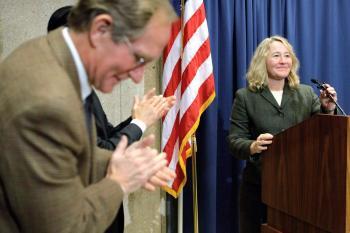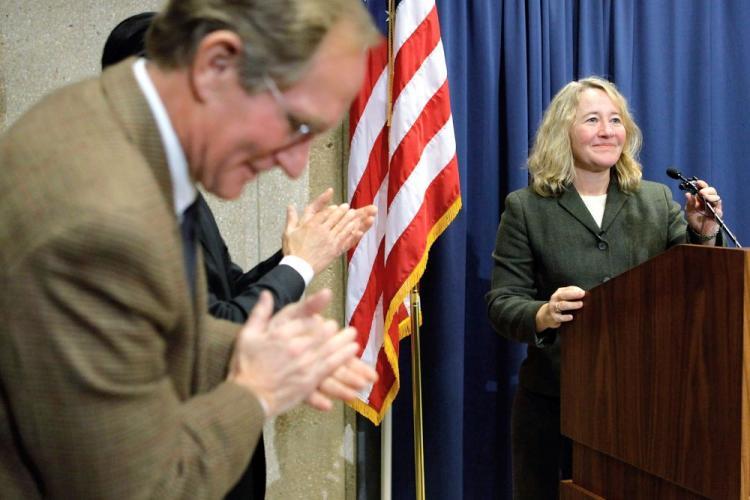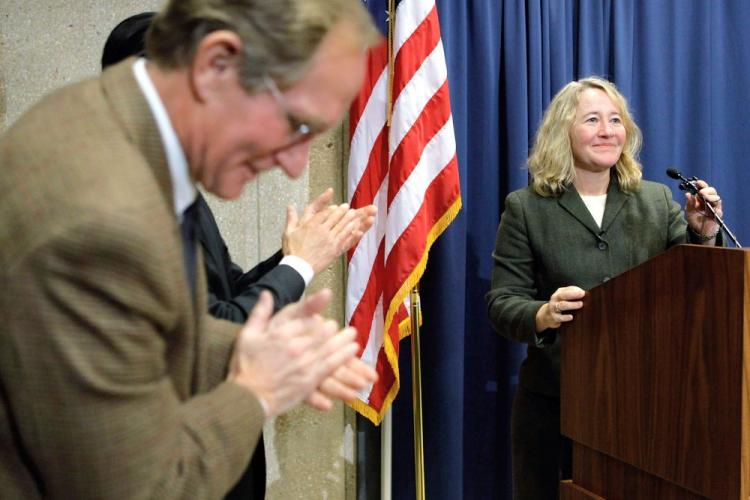STOCKHOLM—The 2009 Nobel Prize in Medicine was announced on Monday by the secretary of the Nobel Comittee, Göran Hansson. This year, it was awarded to Americans Elizabeth H. Blackburn, Carol W. Greider, and Jack W. Szostak for their discovery of how chromosomes are protected by telomeres and the enzyme telomerase.
The laureates solved the problem of how chromosomes can be copied in a complete way during cell divisions and how they are protected against degradation. The solution was found in the telomeres, the ends of the chromosomes, and the enzyme telomerase, which forms them.
Blackburn and Szostak discovered that a unique DNA sequence in the telomeres protects the chromosomes from degradation. Greider and Blackburn then found the enzyme which makes telomere DNA, telomerase.
The fact that chromosomes in the cells can stay young with the aid of telomerase has been a major factor in the research on aging, cancer, and stem cells in recent years.
The prize is split equally between the three laureates, who all live in the United States. Apart from the medal, they will share the sum of 10 million Swedish kronor (roughly US$1.4 million). The award ceremony takes place according to tradition in Stockholm on Dec. 10.
This year marked the 100th time that the Nobel Prize in Physiology or Medicine is awarded, and the announcement could, for the first time ever, be viewed all over the world in real time via YouTube, directly from the Karolinska Institutet, where it is announced.
The laureates, of course, get a phone call just before the press conference.
”The first discovery in this field was made 30 years ago and the last 20 years ago,” Nobel Comittee Secretary Göran Hansson said.
Someone at the press conference wondered why it had taken such a long time for this year’s laureates to get the prize.
Göran Hansson said that there was a maturation process that had to be followed in medicine. The scientific community has to recognize the discovery and someone must nominate the person or persons in question. Then the discovery must be evaluated and it must be decided whether it is more important than others.
Finally, there is the matter of properly investigating who made the first discovery in the field. Another reason why the Nobel Prize in the field of medicine usually isn’t given out quickly is that it must be analyzed and tested in many different ways and different systems.
The laureates solved the problem of how chromosomes can be copied in a complete way during cell divisions and how they are protected against degradation. The solution was found in the telomeres, the ends of the chromosomes, and the enzyme telomerase, which forms them.
Blackburn and Szostak discovered that a unique DNA sequence in the telomeres protects the chromosomes from degradation. Greider and Blackburn then found the enzyme which makes telomere DNA, telomerase.
The fact that chromosomes in the cells can stay young with the aid of telomerase has been a major factor in the research on aging, cancer, and stem cells in recent years.
The prize is split equally between the three laureates, who all live in the United States. Apart from the medal, they will share the sum of 10 million Swedish kronor (roughly US$1.4 million). The award ceremony takes place according to tradition in Stockholm on Dec. 10.
This year marked the 100th time that the Nobel Prize in Physiology or Medicine is awarded, and the announcement could, for the first time ever, be viewed all over the world in real time via YouTube, directly from the Karolinska Institutet, where it is announced.
The laureates, of course, get a phone call just before the press conference.
”The first discovery in this field was made 30 years ago and the last 20 years ago,” Nobel Comittee Secretary Göran Hansson said.
Someone at the press conference wondered why it had taken such a long time for this year’s laureates to get the prize.
Göran Hansson said that there was a maturation process that had to be followed in medicine. The scientific community has to recognize the discovery and someone must nominate the person or persons in question. Then the discovery must be evaluated and it must be decided whether it is more important than others.
Finally, there is the matter of properly investigating who made the first discovery in the field. Another reason why the Nobel Prize in the field of medicine usually isn’t given out quickly is that it must be analyzed and tested in many different ways and different systems.




